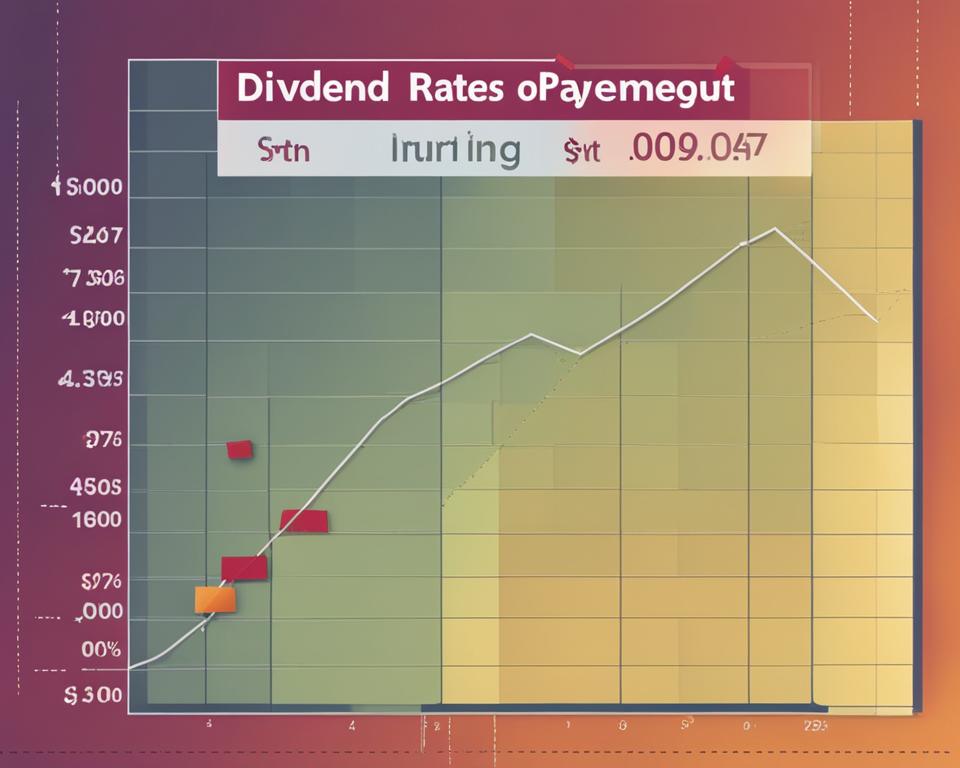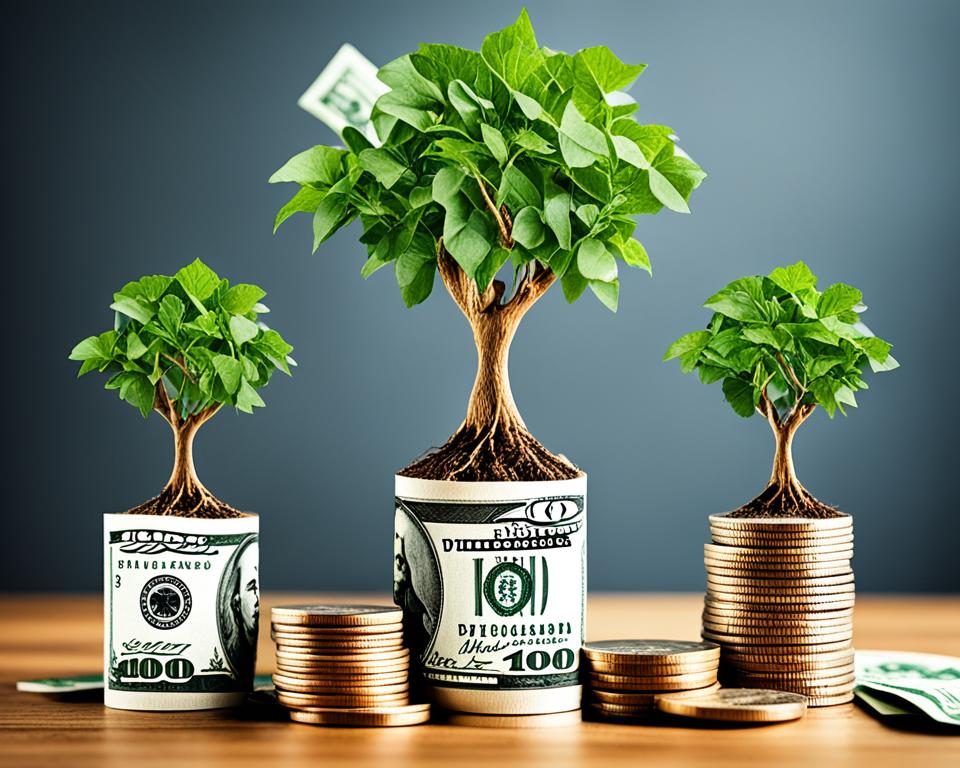When plotting your investment journey, understanding the economic factors affecting dividends is essential. It boils down to a puzzle where the impact of interest rates on dividend payouts plays a cornerstone piece. As you weave through financial markets, you’ll notice how the influence of interest rates on dividend payouts is not just trivia—it’s crucial knowledge that can shape your investment outcomes.
The symbiotic relationship between interest rates and dividend payouts is intrinsic. As a savvy investor, keeping an eye on these shifts can help you calibrate your dividend-gathering strategies efficiently. Interest rate fluctuations aren’t just numbers changing; they reverberate through the entity’s profitability veins, ultimately trickling down to the dividends that find their way into your pocket.
Let’s peel back the layers of this dynamic to better equip you with the know-how to optimize your dividend-focused portfolio amidst the ever-changing tides of economic factors.
Key Takeaways
- Understanding the relationship between interest rates and dividends is key to making informed investment decisions.
- Higher interest rates can dampen company profitability, thus potentially reducing dividend payouts.
- A keen eye on economic indicators can better position your investment portfolio toward favorable dividend yields.
- The influence of interest rates extends beyond dividend amounts, affecting overall corporate financial strategies and investor returns.
- Ensuring portfolio resilience involves strategic adjustments to reflect the current interest rate landscape.
The Role of Interest Rates in Investor Portfolio Strategies
As interest rates fluctuate, the terrain of the investment landscape shifts, prompting investors to re-evaluate their portfolio strategies. These variations influence not only stock and bond investment decision-making but also the larger scheme of asset allocation. Recognizing the role these rates play could mean the difference between a fortified portfolio and one susceptible to market volatility.
Choosing Between Stocks and Bonds
When crafting your portfolio strategies, the current interest rate environment will inform your selection between stocks and bonds. In periods of low interest rates, bonds typically offer less attractive yields, swaying many to lean towards stocks for potentially higher returns. However, it’s essential to consider the inherent risks and the unique attributes each investment type brings to your diverse investment portfolio.
Risk Assessment in Low Interest Rate Environments
Owning stocks during low interest rate risks may seem favorable due to higher return prospects, yet it’s crucial to assess the potential volatility and how it aligns with your risk tolerance. Evaluating sectors that are less sensitive to rate changes, or those offering defensive stability, may provide balance in unpredictable environments.
Portfolio Diversification and Interest Rate Fluctuations
Interest rate fluctuations serve as a critical reminder of the importance of maintaining a diverse investment portfolio. Different asset classes react uniquely to changes in rates. Here’s a breakdown of how various assets have historically responded, providing insight into strategic diversification:
| Asset Class | Response to Interest Rate Increase | Response to Interest Rate Decrease |
|---|---|---|
| Bonds | Price down, Yield up | Price up, Yield down |
| Stocks (General) | Mixed, often negative | Oftentimes positive |
| Stocks (Financial Sector) | Oftentimes positive | Mixed, often negative |
| Real Estate | Negative (higher mortgage rates) | Positive (lower mortgage rates) |
| Commodities | Varies by commodity type | Varies by commodity type |
Asset allocation should be dynamic, adjusting to mitigate the impacts of interest rate changes while striving for growth. With an understanding of the economic underpinnings, you can better navigate the ebb and flow of the finance currents to secure your financial future.
Understanding Dividends and Payout Ratios
When constructing your investment portfolio, the term dividends often occupies a central spot in your strategy. Dating back to 1926, dividends have been instrumental in contributing to the equity returns from U.S. stocks, Standard & Poor’s data shows. It’s these recurring payouts that could form a predictable stream of income, an attribute cherished by investors, especially in retirement planning.
To gauge the health and dividend distribution capacity of a company, you turn to analyzing its payout ratios. This metric provides insight into the portion of earnings allocated to shareholder payments. A sustainable distribution level mirrors the long-term strategy and financial stability of a firm. Typically, a dividend payout ratio calculation gives you the percentage of earnings per share (EPS) allocated to dividends per share (DPS).
Let’s sink into the nuts and bolts of this concept with an example. Assume a company reports annual earnings of $2 per share and pays out $1 per share as dividends. Here, the dividend payout ratio comes out to be 50% —a figure many investors would consider healthy, as it implies the company retains half of its earnings for growth investment, while the other half rewards shareholders.
The distribution strategies across sectors may differ markedly. In areas like utilities or real estate, it’s not uncommon to see higher percentages, given their consistent cash flow and stable earnings. But a skyrocketing payout ratio, say well over 100%, should raise an eyebrow—it might hint that a company is reaching into reserves, or even going into debt, to keep shareholders happy. High payout rates like these call for a cautious approach, as they could spell trouble for dividend longevity.
| Industry Sector | Average Dividend Payout Ratio |
|---|---|
| Utilities | 60-80% |
| Real Estate | 70-90% |
| Technology | 20-30% |
| Healthcare | 30-50% |
| Consumer Goods | 40-60% |
Ultimately, your goal as a dividend investor is to pinpoint those canny enterprises that have mastered the delicate balance between rewarding shareholders generously and reinvesting sufficiently back into the business. They’re the ones who not only survive but thrive across economic cycles, elevating their payouts sustainably over time.
Analyzing the Impact of Interest Rates on Dividend Payouts
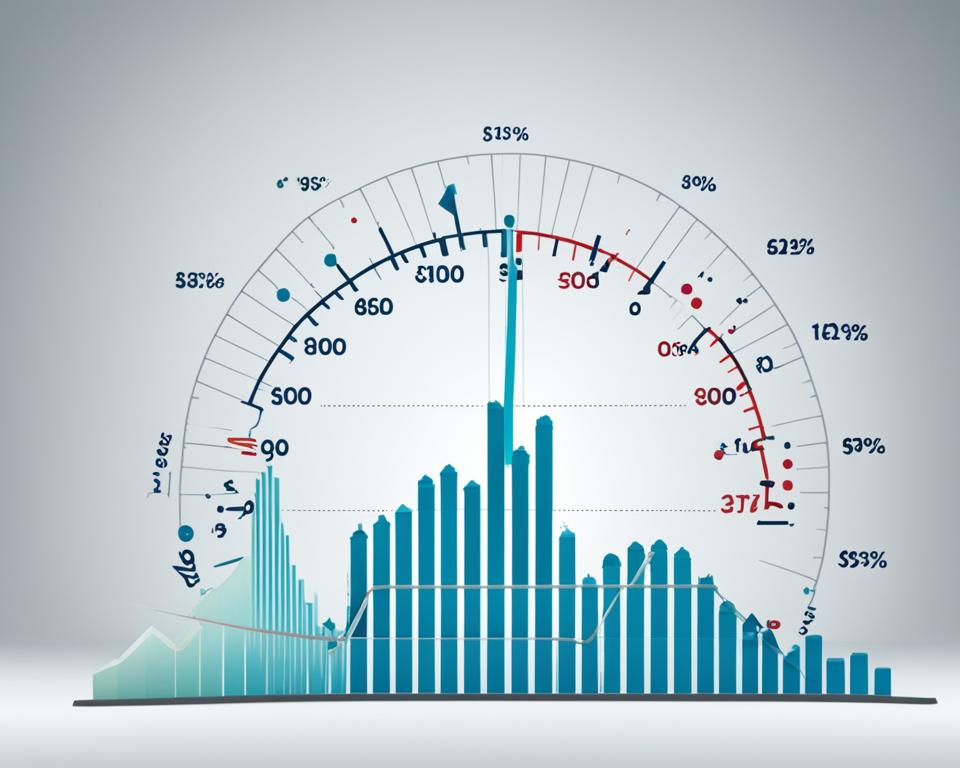
As you explore the realm of investing, you’ll observe that interest rates are more than mere percentages—they hold the power to shape your dividends. The complex interplay of these rates with corporate earnings reveals their significant impact on interest rates on dividends, influencing corporate profitability and, by extension, the sustainability of your prized dividend payouts.
Interest Rates Influence on Corporate Profitability
The trickle-down effect of interest rate adjustments on dividends begins at the core of corporate financing. Heightened rates can quickly turn into a headwind for companies wrestling with hefty debts. As borrowing costs escalate, these enterprises face a crunch in profitability, fiscally constraining them and often leading to strategic reshuffling which can, in turn, affect corporate profitability and the dividends they can afford to dispense.
Changes in Dividend Payout Ratios Explained
Understanding the calculus behind dividend payouts necessitates a look at the dividend payout ratio. It’s a straightforward gauge of how much income a firm returns to shareholders versus what it retains for reinvestment. An uptick in interest rates can disrupt this ratio, compelling companies, especially in sectors like utilities and telecommunications, to recalibrate their dividends amid the fluctuating interest rate impact.
Interest Rate Fluctuations and Dividend Sustainability
The terrain of dividend sustainability is rocky when interest rate fluctuations come into play. Dividend-payers, particularly those in sectors such as real estate investment trusts (REITs), often have to navigate these shifts carefully. The resultant financial pressure could challenge ongoing dividends, making investment choices that focus on dividend sustainability in the face of rate oscillations all the more crucial.
Keep your finger on the pulse of these rate changes. They are a critical barometer for anticipating modifications in dividend strategies and thereby aid in aligning your investment decisions with the goal of achieving a resilient dividend income stream.
Interest Rates Affect Dividend Payouts: The Direct Connection
As you venture into the world of investing, the direct impact of interest rates on dividends is an indispensable aspect to watch. This connection reveals itself prominently in industries harboring substantial debt. For companies in such sectors, a hike in interest rates not only increases the cost of existing debts but also alters their financial strategic planning. This economic shift has a tangible effect on dividends, often prompting a reassessment to sustain shareholder returns.
What is the correlation between interest rates and dividend payouts? As interest rates rise, there is an immediate financial repercussion, especially for those companies relying heavily on leverage. Their increased expenses can erode profit margins, leaving a smaller pool of funds available for dividend distributions. This dynamic highlights the importance of interest rates in investment decision-making, particularly for income-focused investors.
Amidst changing economic climates, corporations frequently find themselves at a crossroads, needing to balance between shareholder expectations for dividends and the realistic assessment of their financial health. This could result in adjusted dividend levels to align with the new economic realities.
Consider the hypothetical scenario where interest rates soar unexpectedly. Sectors with high debt such as utilities or telecommunications might see their stock price taking a hit as their cost of debt capital ratchets up. As these companies revisit their budget allocations, dividends—often regarded as variable costs—may be reduced, affecting investors who rely on these payouts for steady income.
Here’s a look into how different sectors may respond to a rise in interest rates:
| Sector | Average Leverage | Typical Interest Rate Sensitivity | Possible Dividend Adjustment |
|---|---|---|---|
| Utilities | High | High | Increased |
| Telecommunications | High | High | Increased |
| Consumer Goods | Moderate | Moderate | Moderate to Low |
| Technology | Low to Moderate | Low | Low |
| Healthcare | Varies | Moderate | Low to Moderate |
Being aware of this intrinsic link arms you with the foresight needed to adapt your investment portfolio accordingly. When interest rates shift, take a closer look at your dividend-bearing assets and consider how they might be affected. By staying ahead of these economic interplays, you position yourself to maneuver through the winds of change with greater confidence and optimized returns.
How Interest Rates Shape the Dividend Policies of Companies
As an astute investor, you’re likely aware that the landscape of dividend policies isn’t static. A key element influencing this terrain is the ebb and flow of interest rates. Recognizing the nuances of this influence can aid in the curation of a robust portfolio resilient to these economic tides.
Rooted in the complexities of corporate finance, the correlation between interest rates and dividend payouts can be profound. As rates shift, so too does the very foundation on which companies base their dividend policies. Let’s delve into the signposts that underscore the importance of adaptability and financial health in navigating dividend policy adaptation within this context.
The Debt Factor: Considerations for High-Yield Dividend Stocks
One cannot discuss dividend policy adaptation without considering the debt structure of a company. For firms proffering high-yield stocks, the implications of rising interest rates can manifest dramatically. Debt considerations become more pronounced as potential obligations swell against revenues, squeezing profit margins. Such financial strain necessitates a careful assessment of the viability of existing dividend policies.
Effects on Dividend Growth and Consistency Amidst Rate Changes
Shifting interest rates can distort the canvas upon which companies plot their dividend trajectories. Dividend growth, often observed as a hallmark of thriving businesses, may falter under increased financial burden. Yet, amidst these interest rate changes, it is not unheard of for strategic entities to not only uphold but, in some cases, amplify their investor dividends. Consistency, while challenged, is not unattainable—informed corporate action and foresight play pivotal roles.
Case Studies: Companies Adapting to Interest Rate Trends
Let us consider the real-world embodiment of these principles through case studies. Organizations such as Johnson & Johnson, Procter & Gamble, and Exxon Mobil Corp., which exhibit qualities akin to Dividend Aristocrats, demonstrate adaptability to the throes of varying interest rate trends. Their strategic financial decisions and cushion of substantial reserves have allowed a continuance—or growth—of dividend distributions, even when facing economic headwinds.
In your investment journey, tracking how dividend policy adaptation unfolds across different companies and sectors can be enlightening. It offers a window into the future actions these entities might take in response to the shifting tide of interest rates, thus shaping your decisions as you pursue a path toward dividend yield optimization.
Dividend-Paying Stocks in a Low-Interest-Rate Economy
In these times of a low-interest-rate economy, your quest for substantial returns might lead you towards dividend-paying stocks as a lighthouse in a sea of mediocre yields. This investment avenue shines bright, offering an alluring combination of potential income and capital appreciation. As yields on conventional fixed-income investments falter in the low-rate environment, equity investments in stable companies emerge as beacons of hope for your portfolio.
The allure of dividend-paying stocks is magnified when the alternative—parking your funds in traditional savings instruments—typically results in a yield that barely keeps pace with inflation. In such a climate, equities that consistently pay dividends can serve as a key pillar in building a resilient financial future. They often come from companies entrenched with sturdy balance sheets and predictable cash flows—qualities that can endure the ripples of economic twists.
But why do these stocks often become the darlings of the investment world during these economic spells? It’s because they can provide you with a dual-edge sword; steady income through dividends and a chance for equity investment growth. Companies, particularly in sectors like utilities and real estate, that not only resist the tides of market volatility but continue to reward investors with dividends, stand out as attractive ports where your investment ships can dock safely.
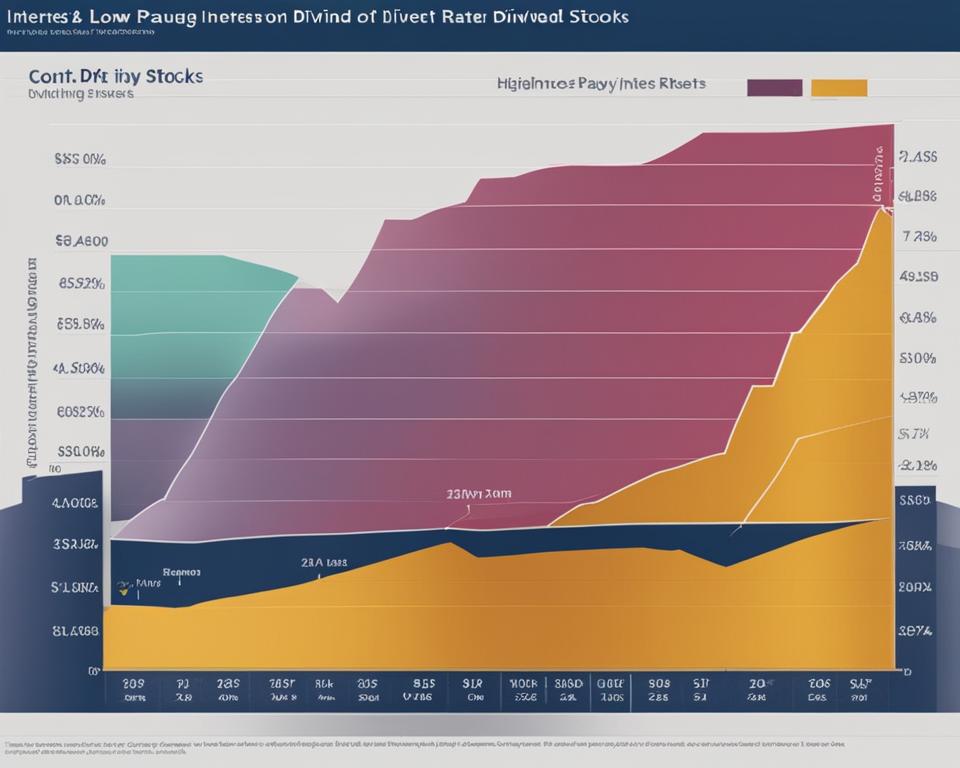
Moreover, a shining attribute of dividend-rich equities is the psychological comfort they provide. With the predictability of regular payouts, your portfolio can harness a flow of income that cushions against the market’s ebb and flow. This feature is particularly alluring if you’re navigating the financial waters eyeing retirement on the horizon or seeking a more predictable income stream.
Within this context, let’s take a closer look at the potential benefits derived from dividend-paying equities in a low-interest-rate scenario, and why they may deserve a prominent role in your investment symphony:
- **Dividend Yield versus Traditional Interest**: In a low-interest-rate economy, dividend yields often surpass the interest offered by savings accounts, CDs, or government bonds, delivering a more tempting yield on your investment.
- **Potential for Growth**: While fixed incomes stagnate, stock markets have the potential to grow. Your carefully selected dividend-payers might appreciate in value, delivering capital gains alongside dividend income.
- **Tax Efficiency**: Qualifying dividends may be taxed at a lower rate than interest income, offering you a more efficient after-tax return, thus singing a sweeter tax tune.
- **Diversification**: Integrating dividend stocks into your portfolio adds a layer of diversification that can improve overall investment health, especially when non-equity markets show anemic performance signs.
However, remember that while dividend-paying stocks can sing melodiously in a low-interest-rate choir, they’re not without their risks. The key to a harmonious portfolio is understanding each investment’s nature, aligning it with your financial goals, and tuning your asset allocation to adjust for the changing market conditions.
It’s worth considering these equity investments as part of your broader financial strategy. Like any seasoned conductor, ensure your portfolio is composed of a variety of instruments, allowing the high notes of growth to resonate well within your risk tolerance and long-term financial objectives.
The Influence of Federal Reserve Policies on Dividends
As you traverse the investment landscape, it’s imperative to consider how the Federal Reserve policy, particularly the federal funds rate, exerts its influence on dividends. The nuances of these policies have ripple effects across the financial ecosystem, impacting company borrowing costs, investor sentiment, and by consequence, your returns. This intricate relationship underscores the importance of monitoring Federal Reserve actions as you craft a resilient dividend-generating portfolio.
Understanding the Federal Funds Rate Impact on Dividends
The federal funds rate, which is the rate at which depository institutions lend funds to each other overnight, is a critical barometer for the health of the U.S. economy. A pivot in this rate can signal changing economic conditions, which often prompts a reassessment of corporate financial strategies and the potential for dividend payouts. Investors who understand the dynamics at play between the federal funds rate and dividend tendencies can better anticipate and react to the adjustments in their income streams.
Market Psychology: Investor Reactions to Rate Changes
Market psychology plays a pivotal role in determining how investors react to changes in Federal Reserve policy. Should the Federal Reserve signal an increase in rates, market sentiment can swiftly shift to a risk-off mood, prompting a flight to safety and a possible devaluation in dividend stocks. Conversely, a rate decrease announcement might lead investors to favor higher-yielding dividend stocks amid a search for income, providing a temporary boost to stock valuations.
Policy Announcements and Their Immediate Effects on Stock Valuations
When the Federal Reserve speaks, markets listen — and react. Policy announcements can have immediate effects on stock valuations, with investors and traders making swift moves in anticipation of the policy’s impact on corporate profits and dividend distributions. Financial institutions, in particular, can see immediate benefits from an interest rate hike, as their margins on lending may improve, bolstering profits and potentially leading to increased dividends for investors.
Your understanding of these dynamics, filtered through the lens of Federal Reserve policies, can arm you with the knowledge necessary to make informed decisions in your pursuit of sustainable dividends. By keeping a keen eye on federal funds rate trends and market psychology following policy changes, you’re better equipped to navigate the policy impact on stock valuations and your investment outcomes.
Comparing Dividend Yields to Interest Rates Across Different Markets
Investors often seek to enhance their portfolio’s earning potential by juxtaposing dividend yields with prevailing market interest rates. This investment yield comparison serves as a pivotal compass to inform and steer investment strategies. Fixed-income securities like U.S. Treasury bonds, heralded for their safety, oscillate with market rates, becoming either more or less attractive compared to the potentially higher, but riskier, yields from dividend-paying stocks.
As the investment landscape evolves, new questions emerge: How do market interest rates influence investor decision-making? and What role do dividend yields play in the broad spectrum of available investment options? The answers lie in a thorough comparative examination of returns across various markets and instruments.
To illustrate this comparison, consider the following scenario: The U.S. Treasury bond yield rises in response to adjustments in federal policies, nudging it close to or above the average dividend yield of the S&P 500 index. Here, the guaranteed return from government bonds might sway some investors towards bonds’ safety, away from the appeal of dividend stocks. Conversely, when interest rates fall, leading to diminished returns on bonds, dividend-paying stocks can become more attractive as they provide not only a potential for yield but also for capital appreciation.
Deciphering the relationship between these yields and interest rates elucidates where investors may find value and how market trends could shepherd them towards different vehicles—equities for growth and yield, bonds for stability, or a blend that captures the best of both worlds. Let’s pore over the data.
| Instrument | Average Yield | Interest Rate Sensitivity | Investment Appeal |
|---|---|---|---|
| U.S. Treasury Bond (10-year) | Varies with Fed policy | High | Safe-haven during volatility |
| S&P 500 Dividend Yield | Varies with market performance | Medium to Low | Growth and income potential |
| Corporate Bonds | Dependent on credit rating | Medium | Balanced yield and safety |
| High-Yield Bonds | Higher yields | Low to Medium | Income potential with risk |
Your journey through financial markets is nuanced with considerations of both dividend yields and market interest rates. Balance is key, as changes in either can affect the valuation of your investments. By staying informed and agile, you can adjust your portfolio to embrace these changes—extracting value, mitigating risk, and journeying towards your financial objectives with a well-honed strategy.
High Interest Rates and Their Consequences for High Dividend Stocks
Navigating the investment universe requires astute awareness of the tides and currents driven by economic indicators. When these signals point towards high interest rates, they exert an undeniable force on the financial market, especially on high dividend stocks. For shareholders accustomed to ample dividend yields, understanding the unfolding scenario is paramount to maintaining portfolio health.
Cost of Debt: How Rising Rates Affect Corporate Dividend Decisions
The escalation of interest rates spells a cautionary tale for companies accustomed to leveraging debt as a means of business growth and expansion. These companies must now confront the impact of high interest rates on their cost of capital, which in turn squeezes margins and reorients financial roadmaps. As debt becomes more expensive, dividend distributions are often the first variable to undergo scrutiny. Firms with high dividend yields, particularly affected by this cost increment, may find themselves rethinking their payout strategies to preserve their financial buoyancy.
Stock Valuation Adjustments in Response to Increasing Rates
The changing landscape has immediate reflexivity in the form of stock valuation adjustments. Investors recalibrate their expectations for future earnings due to the increased costs for companies carrying substantial debt. The market responds by repricing these stocks, factoring in the heightened risk of reduced profitability. An important element, the discounted cash flow model, adjusts to integrate these new, costlier debt conditions, often leading to lower valuations and diminished investor appeal.
The Challenge of Maintaining Attractive Dividend Yields
Persistently maintaining dividend yields in a high-interest-rate environment is undeniably challenging. Companies must reconcile shareholder expectations with reality—a reality in which the cost of debt servicing competes with the cash flow required to sustain generous dividends. This competition poses a hurdle for companies striving to offer attractive yields, especially when traditional, low-risk, fixed-income securities become more appealing due to comparable or superior interest returns.
Investors, therefore, are urged to consider the landscape and scrutinize the debt cost on dividends, gauging whether high-yield stocks are capable of preserving their luster in an ever-evolving financial cosmos.
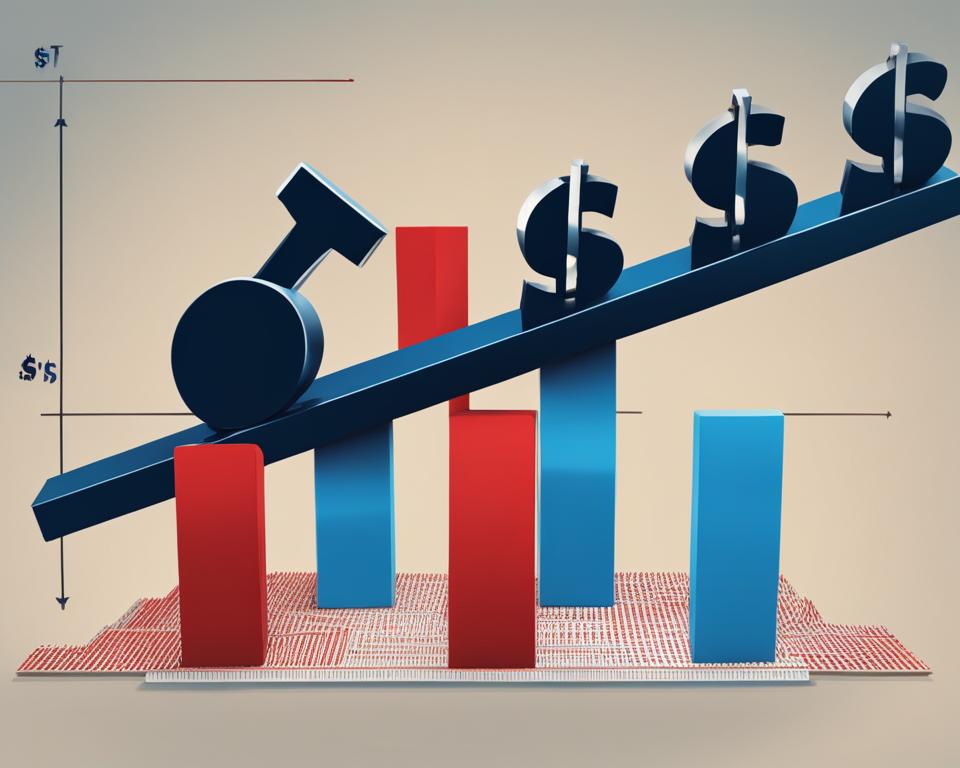
As you pilot through these economic skies, it’s crucial to hold your course steady, watching the horizon for hints of rate shifts and their profound reverberations across dividend payers. The following table projects a simplified forecast of how high dividend stocks under various sectors might respond to an uptick in interest rates:
| Sector | Interest Rate Sensitivity | Projected Dividend Adjustments |
|---|---|---|
| Utilities | High | Potential Decrease |
| Telecommunications | High | Potential Decrease |
| Consumer Staples | Medium | Stable to Moderate Decrease |
| Healthcare | Low | Stable |
| Technology | Low | Stable to Potential Increase |
In the face of such shifts, your adaptability as an investor—and your portfolio’s resilience—will be tested. With careful vigilance and strategic forethought, you can weather the storms of high-interest rate environments and steer towards financial success.
Coping with Rate Hikes: Strategies for Dividend Investors
Confronted with interest rate hikes, you—as an investor—may find your dividend returns pressured under the weight of the new economic reality. Yet, there are strategies savvy investors can adopt to navigate these changes and continue to thrive. Key to adapting is your knowledge and utilization of investor strategies for dividends that align with the climates of higher rates. Here we explore actionable steps you can take to mitigate the impact on your investment returns.
One of the core strategies is targeting sectors that are traditionally insulated or can, in fact, benefit from rate hikes. This includes sectors such as financials, which may see an upswing in profitability as interest rates rise. Another approach could be leaning towards consumer staples, a category often less sensitive to dips in consumer spending that can accompany rate increases. These sectors can offer more stability and adjustable dividend strategies that adjust to changing economic tides.
Another countermove involves the deft use of fixed-income instruments. Shifting focus to shorter-term bonds can protect your portfolio from the effects of rate increases, as these generally demonstrate less sensitivity to rate shifts when compared to their long-term counterparts. This tactical shift can provide a defensive buffer within your investment spread.
Let’s break down these strategies into a clear, actionable table that you can consider as part of your investment playbook when dealing with interest rate hikes:
| Strategy | Description | Benefits |
|---|---|---|
| Focus on Financial Sector | Invest in banks, insurers, and other financial entities that benefit from wider interest margins. | Potential for increased profitability and dividends as interest rates rise. |
| Lean on Consumer Staples | Target companies that offer essential goods, which face steadier demand regardless of economic swings. | Dividends are more resilient, potentially offering stability even in volatile markets. |
| Invest in Shorter-Term Bonds | Reduce exposure to long-term bonds in favor of shorter-term bonds which are less sensitive to interest rate hikes. | Provide a safer return and shield against the reduced bond prices that come with rate hikes. |
Remember, adjusting your portfolio in response to rate hikes is not just about reacting defensively but also about recognizing and capitalizing on opportunities that arise. Flexible, strategic planning and pertinent awareness of market sensitivities can empower your investment decisions and enhance your portfolio’s resilience against rate fluctuations.
By incorporating these strategies into your investment framework, you can help ensure a robust dividend stream that weathers the tumultuous seas of rising rates. Keep abreast of market trends and refine your approach continuously—your foresight and flexibility are vital in dealing with interest rate hikes.
Opportunities for Dividend Growth in a Rising Rate Environment
While rising interest rates may seem daunting for dividend investors, it’s crucial to recognize not all sectors are equally affected. In fact, certain sectors showcase impressive resilience, offering lucrative dividend growth opportunities despite the upward pressure on rates. Understanding which sectors thrive in this environment is key to crafting a robust dividend investment strategy.
Identifying Sectors Resilient to Interest Rate Increases
To safeguard your dividends against the onslaught of rising rates, focusing on sectors resilient to rising rates is imperative. Industries with strong cash flow profiles and lesser reliance on debt for operations typically withstand the headwinds of rate hikes and continue to provide reliable dividend growth opportunities. Amongst these, infrastructure and basic services are notable for their inherent demand stability, translating into persistent revenue streams and, consequently, steady dividends.
Exploring Dividend Aristocrats and Their Performance
Dividend Aristocrats, a group of S&P 500 companies known for consistently increasing dividends for at least 25 consecutive years, offer a glimpse into the kind of stellar Dividend Aristocrats performance investors can rely on. The resilience of these companies, such as Johnson & Johnson and Procter & Gamble, exemplifies how a well-rounded business model can effectively manage through diverse economic cycles, presenting attractive dividend growth opportunities even when rates are climbing.
Financial Sector: A Haven for Dividend Growth Amidst Rate Hikes
The financial sector dividends stand out, particularly during periods of interest rate hikes. Banks and insurance companies can be the sanctuaries for your dividends. Higher interest rates can lead to wider net interest margins, directly benefiting these institutions’ profitability. As a result, they often manage not only to maintain but sometimes to increase their dividends, which makes them a compelling consideration for your income-generating portfolio.
| Sector | Interest Rate Sensitivity | Dividend Growth Potential |
|---|---|---|
| Financial Sector | Low to Positive | High |
| Utilities | High | Moderate to Low |
| Consumer Staples | Low | High |
| Real Estate | High | Low to Moderate |
| Technology | Low | Moderate to High |
As rate hikes loom, aligning your portfolio with the right sectors is a strategic maneuver that can not only safeguard your dividend income but also potentially enhance it. By staying abreast of sector performances and leaning on benchmarks like the Dividend Aristocrats, you position yourself to unlock the growth concealed within a rising rate environment.
Comparison of Dividend Payouts During Rate Cuts Versus Rate Hikes
In the world of investing, the impact of interest rate shifts on your returns cannot be overstated. Engaging in a dividend payouts rate cuts comparison, you’ll find that the environment of rate declines generally provides a tailwind for corporate expansion and consumer spending. This fosters a fertile ground for robust dividend-payout prospects. Conversely, when the rates advance northward, the increased borrowing costs often lead to a squeeze on dividend sustainability, especially in certain market sectors. Understanding these dynamics can be essential for developing a resilient investment strategy that adapts to the changing economic climate.
Let’s delve into the effects of rate hikes on dividends in contrast with rate cuts by examining industry responses to both scenarios. Companies in interest rate-sensitive sectors, such as utilities and telecommunications, might react to these fluctuations in markedly different ways. A rate cut may trigger a rise in their stock value and enable higher or sustained dividend payouts. However, rate hikes might constrict their ability to pay dividends at previous levels due to increased costs of servicing debt.
| Interest Rate Movement | Corporate Borrowing Cost | Consumer Spending | Dividend Payout Tendency |
|---|---|---|---|
| Rate Cut | Decreases | Increases | Likely to increase or stay constant |
| Rate Hike | Increases | Decreases | Challenged, may decrease |
As a seasoned investor, it’s valuable to note that while sectors like utilities might struggle in a rising rate environment, other sectors could stand up well or even flourish. The financial sector, for example, may benefit from a rate rise through improved interest margins, potentially translating to enhanced dividend payouts.
- Rate cuts can be a boon to dividend growth, as lower interest rates often lead to escalated aggregate spending and corporate expansion.
- The burden of rate hikes can be significant for companies with high debt levels, potentially resulting in a reevaluation of dividend strategies.
- Some sectors may defy the typical challenges posed by rate hikes and continue to deliver strong dividend growth.
The tactical investor within you may already perceive these interest rate movements as fundamental indicators that steer the direction of your portfolio. By keeping a pulse on Federal Reserve decisions and macroeconomic trends, you can endeavor to align your investment choices with the sectors poised to thrive or at least weather the storm in differing interest rate landscapes.
Examining the Relationship Between Interest Rates and REIT Dividends
As you seek to fortify your investment portfolio, the intricate relationship of interest rates and REIT dividends demands your attention. REITs, with their significant holdings in real estate assets, exhibit marked sensitivity to the ebbs and flows of interest rates. This can lead to palpable effects on their dividend yield—effects that smart investors like you need to consider. Let’s dissect this critical relationship to understand how it impacts your investment decisions.
REITs Sensitivity to Interest Rate Shifts
Understanding REITs’ market sensitivity is key when it comes to rate fluctuations. These trusts often operate with a high level of debt, making them particularly exposed to interest rate changes. An uptick in rates generally signals rising borrowing costs, which can dent the bottom line and in turn, impact dividends. On the flip side, a rate cut can ease debt servicing and potentially lead to higher dividend payouts. As interest rates inch up or down, the ripple effects felt throughout REITs’ financial structures call for a meticulous watch on your assets.
Investor Sentiment and REIT Dividend Adjustments
Investment sentiment closely aligns with interest rate trends, influencing how REIT dividends are perceived. When rates climb, the attractiveness of REIT yields compared to safer bond yields gets scrutinized. Conversely, in a falling rate environment, REITs might become the golden child of income-seeking investors. The shifting investor sentiment can lead to volatility in REIT share prices and cause management teams to adjust dividend policies. Monitoring these trends is crucial for maintaining a pulse on the potential trajectory of your REIT holdings.
Positioning REITs in Your Income-Generating Portfolio
Positioning REITs within your portfolio demands a strategic approach, especially when it comes to navigating the interest rate landscape. Diversifying your holdings across various sectors, including REITs less impacted by rate hikes—such as those with long-term fixed mortgages—can provide income generation with a measure of insulation against rate changes. Additionally, keeping an eye on REITs with a track record of managing through different rate environments can help anchor your income expectations amidst uncertainty.
While you can’t control interest rate movements, you can control how you respond. By staying well-informed, recognizing the relationship between interest rates and REIT dividends, and positioning your investments thoughtfully, you become better equipped to harness REITs’ potential and contribute to a robust, income-generating portfolio despite the shifting economic currents.
Interest Rates and Global Dividend Payouts: A Cross-Border Perspective
As an investor, you’re well aware of how local interest rates affect dividend payouts. But have you considered the global impact of interest rate fluctuations on dividends? In a financially interconnected world, the effect of interest rates on dividend strategies crosses borders, influencing global investment flows and dividend income potential. A keen understanding of this can broaden your investment horizons and inform your choices as you pursue optimal yields.
High interest rates in one country can shift investor funds overseas to seek better dividend opportunities in regions where corporate borrowing costs are lower, thereby improving dividend payouts. Conversely, if a country experiences lower interest rates, global capital may flow out, chasing higher yields in more lucrative markets. This global hunt for dividends can significantly impact your international holdings.
To help shed light on this, let’s assess how different regions might fare when adapting their dividend disbursements in the face of interest rate changes. Consider the following cross-regional dividend comparison under shifting rates:
| Region | Interest Rate Trend | Dividend Payout Reaction |
|---|---|---|
| United States | Rising | Conservative adjustment to payouts |
| European Union | Stabilizing | Moderate increase in payouts |
| Emerging Markets | Variable | Payouts influenced by currency strength and inflation |
| Asia-Pacific | Decreasing | Higher payout potential due to lower borrowing costs |
Further, multinational corporations often repatriate funds, which means that the prevailing interest rates in their home countries can influence dividend policies. For instance, a U.S. multinational may adjust its global dividend payout policy in reaction to the Federal Reserve’s stance on interest rates. This interplay underscores the complexity that you, as an investor, must navigate when constructing a diversified, dividend-yielding portfolio.
It’s vital for you, too, to consider currency exchange rates when assessing the attractiveness of foreign dividends. A stronger domestic currency relative to the currency of the dividend-paying country may diminish your returns once converted.
In conclusion, keeping tabs on the international interest rate climate is more than a prudent practice—it’s an essential part of managing your global investment portfolio. By carefully balancing your exposure to domestic and international dividend-payers, you can strive for a portfolio that’s robust to interest rate volatilities, whether at home or abroad.
Conclusion
As we’ve journeyed through the economic terrain, scrutinizing the vital relationship between interest rates and dividend-paying securities, a central theme has emerged: vigilance and strategy are key. You’ve seen how dividends form an integral part of the total return from stocks, with their allure waxing and waning in response to interest rate tides. This ebb and flow, while sometimes predictable, often demands a disciplined and well-informed approach to investing.
Summarizing the Influence of Interest Rates on Dividend Paying Securities
The essence of what you’ve gathered paints a clear picture: interest rate shifts wield a powerful influence on the profitability of companies and their ability to maintain or grow dividends. When rates rise, the increased cost of debt can stifle corporations that are heavily leveraged, leading to potential dividend cuts. Conversely, rate cuts can free up capital, enabling companies to enhance their dividend offerings. These patterns underscore the necessity for you to constantly gauge the pulse of the economy, ensuring that your investments in dividend-paying securities align with current and projected interest rate landscapes.
Future Outlook: Preparing for Interest Rate Changes as a Dividend Investor
Looking ahead as a dividend investor, it’s crucial to anticipate and prepare for interest rate changes. Your future success hinges not only on recognizing which sectors historically flourish under higher or lower rates but also on potentially diversifying into safer, high-yield opportunities when the economic signals dictate. Furthermore, understanding the global perspective on interest rates can broaden your scope, allowing for strategic allocations to international markets that could offset domestic fluctuations. Through this lens of preparedness, you stand poised to adapt swiftly, securing dividend income and protecting your investment portfolio against the unpredictable waves of interest rates.
FAQ
How do economic factors such as interest rates affect dividend payouts?
Interest rates have a direct impact on dividend payouts as they affect corporate profitability and investor decision-making. Higher interest rates can increase debt servicing costs for companies, which might lead to lower dividend payouts. Conversely, lower interest rates may improve profitability and encourage higher dividends.
What role do interest rates play in investor portfolio strategies?
Interest rates are central to crafting portfolio strategies. They influence the choice between stocks and bonds, as lower rates can make dividend stocks more attractive, and higher rates can make bonds appealing for their income potential. Investors must also consider portfolio diversification to buffer against interest rate fluctuations.
How are dividends and payout ratios calculated?
Dividends are typically calculated based on a company’s profitability and the dividend policy. The payout ratio is calculated by dividing the dividends per share (DPS) by the earnings per share (EPS). A sustainable payout ratio indicates a company’s ability to maintain dividend payments over time.
What is the direct connection between interest rates and dividend payouts?
The direct connection is that as interest rates increase, the cost of borrowing goes up for companies, which can lead to a reduction in dividends. For dividend-rich stocks, especially in sectors with high debt like utilities, this can mean a reassessment of dividend levels to maintain financial health.
How do interest rates shape the dividend policies of companies?
Companies with high debt and high-yield dividends need to be cautious in a rising interest rate environment as the increased cost of borrowing can squeeze profitability and force dividend cuts. Conversely, well-managed companies with adaptive dividend policies may maintain or grow dividends despite rate changes.
How attractive are dividend-paying stocks in a low-interest-rate economy?
Dividend-paying stocks become more attractive in a low-interest-rate economy because they can offer higher yields compared to other income-generating investments like savings accounts or government bonds, drawing investors who are seeking income along with potential capital appreciation.
How do Federal Reserve policies impact dividend payouts?
The Federal Reserve’s policies, especially changes in the federal funds rate, affect corporate borrowing costs and the economic climate, which can influence investor sentiments and ultimately impact dividend payouts and stock valuations.
Why is it important to compare dividend yields to interest rates across different markets?
Comparing dividend yields to market interest rates is crucial as it affects investment decision-making. When fixed-income securities offer competitive or higher yields than stocks, investors might shift their focus, impacting stock market dynamics and dividend policies.
What are the consequences of high interest rates for high dividend stocks?
High interest rates can lead to increased borrowing costs for companies, impacting those offering high dividends. Companies may need to adjust their dividend policies and find a balance between maintaining an attractive yield and managing risk, which can be challenging.
How can investors cope with rate hikes?
Investors can cope with rate hikes by shifting their focus to sectors that traditionally benefit from higher rates, such as financials, or those less sensitive to consumer spending changes, like consumer staples, and by rebalancing their portfolios with shorter-term bonds or assets with lower interest rate sensitivity.
What opportunities exist for dividend growth in a rising rate environment?
Opportunities for dividend growth in a rising rate environment include investing in sectors resilient to the interest rate increases, exploring Dividend Aristocrats known for consistent dividend hikes, and considering the financial sector, where higher rates can improve net interest margins.
How do rate cuts compare to rate hikes in terms of their influence on dividend payouts?
Rate cuts generally lead to lower borrowing costs and can boost corporate and consumer spending, which supports dividend payouts. Rate hikes, on the other hand, can create tighter capital conditions, reducing spending and presenting challenges in sustaining or growing dividends, especially for rate-sensitive sectors.
How do interest rates affect REIT dividends?
Interest rates significantly influence REIT dividends as they impact borrowing costs and property values. REITs are particularly sensitive to interest rate shifts, and investor sentiment towards these assets can fluctuate accordingly, leading to potential dividend adjustments.
What is the impact of interest rates on global dividend payouts?
Interest rates affect global dividend payouts by influencing economic growth, currency strength, and international investment flows. Rate changes in one country can ripple through global markets, affecting the profitability of multinational companies and their ability to pay dividends.

